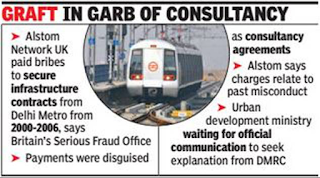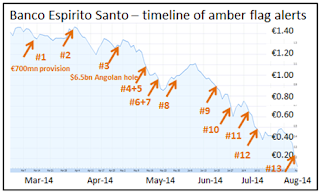Saipem, a 30%-owned subsidiary of ENI, is under
investigation in the US, in Italy and in Algeria for alleged bribes of $275mn
supposedly paid out to various Algerian public figures and other intermediaries
to secure some $10Bn of pipeline construction contracts in that country. The
main corruption trial starts in Italy on February 6th and another parallel
trial is set to start in Algeria shortly ("l'affaire Sonatrach 2").
As stated
on Tuesday, ENI
itself is under investigation by Nigerian, Italian and US authorities for a
major Nigerian bribery case. The
Algerian investigation was started formally in 2011, whilst ENI and
Snamprogetti (a subsidiary of Saipem) were still covered by a two year deferred prosecution agreement after paying
$365 million in fines for an earlier bribery case in Nigeria. Back in 2011
ENI owned 43% of, and "exercised control over" Saipem: it still does,
despite having reduced its stake to 30.5%. The initial indications and internal
alerts are said to go back to 2009.
In 2012
the Italian inquiry picked up steam and heads
started to roll. In December that year Saipem's CEO resigned and two senior
executives were suspended. That same week the CFO of its parent company, ENI,
stepped down (he had previously been the CFO of Saipem). Initially the
investigation focused on pipeline contracts valued at $580mn with notional
bribes of between $180-200mn which sounded somewhat excessive: in time the
information has grown to suggest contracts to the tune of $10bn and payments of
$275mn.
The role of Farid Bedjaoui
In August
2013 an Algerian blog started to set out details of who paid what amounts and
via what corporate structure (another example
of why one should monitor the periphery). The name of Farid Bedjaoui had
first surfaced in February of that year, but the Algerie-focus
article
on the Sonatrach-Saipem 'scandal' if true, suggested that his role was far
more that a mere intermediary between Saipem and Sonatrach. It is alleged
that Mr Bedjaoui was contracted by Saipem to help the company gain
contracts from Sonatrach in return for a commission of 3%. It is also alleged that of this 3% certain
amounts found their way back to senior officers of Saipem. Mr Bedjaoui is thought to currently reside in
Dubai, keeping
away from the law: he has an Interpol red notice on him.
The
article suggested that Bedjaoui, nephew of a past Algerian Minister of Justice
and Ambassador to France and to the UN for Algeria (Mohamed Bedjaoui) in
fact had been helping one Chakib Khelil whilst the latter was still CEO of
Sonatrach and prior to his elevation to Minster of Energy & Mines. During this earlier period Sonatrach decided
to liquidate key holdings that the State oil company had in Duke Energy and
Anadarko and to invest the proceeds with Russell Investments. The latter had an agreement with a
Dubai-based "asset manager" which acted as its agent
throughout the Middle-East called Rayan Asset Management. The co-founder of Rayan Asset Management was
a certain Farid Bedjaoui, who can be seen clearly in the attached
photograph - bottom right.
Saipem COO turns State's witness
In
February 2014 matters took a serious turn for both Saipem and ENI with Saipem's
ex-COO, Pietro Varone telling prosecutors that Paolo Scaroni, CEO of ENI not
only knew of the scheme but that "he knew everything". Mr Scaroni states that he
had no involvement in any 'agreements' between Saipem and the Algerian Minister
or his middleman: yet one email date July 10th 2008 seized by the Italian
prosecutors refers specifically to "meeting between Scaroni and
F". Pietro Varone claims he set up
the meeting and that "F" was Farid Bedjaoui.
Subsequently
the Italian authorities not only increased their focus on the role of ENI's
then-CEO Paolo Scaroni, but also investigated
the transactions of his family trust. Mr Scaroni subsequently resigned from
ENI. In October 2015 both Mr Scaroni and ENI were cleared
of any wrongdoing in the Saipem bribery case, whist six Saipem managers and
ex-managers were sent for trial.
However
in February 2016 a higher court overturned the acquittal and in July of last
year Mr
Scaroni was once again indicted, this time on the back of a large batch of
embarrassing documentation.
Panama Papers happens...
On July
25th 2016 the ICIJ published a major article about the use of hidden offshore
companies to pay bribes and "commissions" to key players in major
resource contracts across Africa: the cause
celebre that the ICIJ used for the cover
story was that of Saipem and Sonatrach.
In his work as the apparent middleman, Mr Bedjaoui had used Mossack Fonseca to create twelve of the
seventeen offshore companies being investigated by the Italian authorities
regarding the Saipem investigation.
"Italian investigators described one of those companies, Minkle Consultants S.A., as a “crossroads of illicit financial flows” that channelled millions of dollars from subcontractors to an array of recipients whose identities are still being untangled."
The Saipem trial is set to begin on February 6th. It will doubtless be closely watched by both
the DoJ and the SEC. If Saipem is found
to have knowingly broken the law at a time when one of its own subsidiaries was
being tried and then sentenced in the US for FCPA offenses, and were the court
to find that Mr Scaroni had direct or indirect knowledge of the affair(as per
the statement by Saipem's ex-COO), both Saipem and its parent ENI may find that
US leniency can run dry.

















